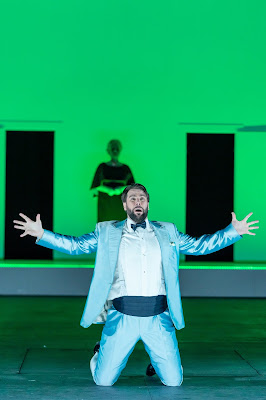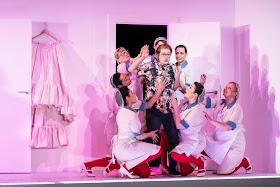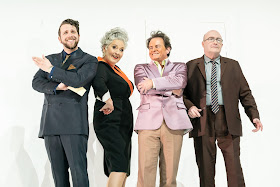 |
| Mozart: The Marriage of Figaro - Rowan Pierce, Hanna Hipp, Louise Alder, chorus - English National Opera 2020 (Photo © Marc Brenner) |
Reviewed by Robert Hugill on 14 March 2020 Star rating: (★★★★½)
Theatre director Joe Hill-Gibbins provides a refreshing take on Mozart's masterpiece, with an emphasis on character
 |
| Mozart: The Marriage of Figaro - Božidar Smiljanić, Susan Bickley in the background English National Opera 2020- (Photo © Marc Brenner) |
Mozart and da Ponte's innovation wasn't to mix comic and seria characters (this had already been done by Galuppi and Goldoni in Venice in the 1750s and 1760s), though from Mozart's letters to his father it was clear that his interest was in this mixture of comic and serious characters. But where the opera broke new ground was in treating the whole piece as music drama, depicting the comic characters with the same depth as the serious ones.
It is this balance between comic and serious that makes Mozart's Le nozze di Figaro delicious, and it is a balance that is difficult to get right. Productions can often get bogged down in the fact that this is great music, and the farce elements just are not funny, conversely if things are too comic then we do not invest enough in the characters. The Count must be a real threat, his actions must count so that the great moment at the end of Act Four when he begs for mercy from the Countess is suitably transformative.
For the new production of Mozart's The Marriage of Figaro (Le nozze di Figaro) at the London Coliseum, English National Opera chose the theatre director Joe Hill-Gibbins, with strong cast including Johnathan McCullough as the Count, Elizabeth Watts as the Countess, Louise Alder as Susanna, Božidar Smiljanić as Figaro, Hanna Hipp as Cherubino, Susan Bickley as Marcellina, Andrew Shore as Dr Bartolo, Colin Judson as Don Basilio and Don Curzio, Clive Bayley as Antonio and Rowan Pierce as Barbarina. The work was conducted by Kevin John Edusei. Lighting was by Matthew Richardson, with choreography by Jenny Ogilvie and the translation was by Jeremy Sams.
The activities of La folle giornata, the crazy day at the Almaviva's palace are perhaps an apt metaphor for our crazy times, and we must be grateful that the performance was able to go ahead.
Joe Hill-Gibbins directed Thomas Ades' Powder her Face for ENO in 2014, and Mark-Anthony Turnage's Greek in a co-production between the Brooklyn Academy of Music, Scottish Opera and the Edinburgh International Festival in 2017/18. The Marriage of Figaro was a co-production with Oper Wuppertal where the production has already appeared in 2019. He seems to have approached The Marriage of Figaro with less reverence and more theatricality than some directors, perhaps his being primarily a theatre director meant that his production came with rather less historical operatic baggage. Unlike some directors, Hill-Gibbins and his design team seem to have given a lot of thought to the problems of producing a small to medium scale piece like The Marriage of Figaro in a large theatre like the London Coliseum using young voices.
 |
| Mozart: The Marriage of Figaro - Johnathan McCullough - English National Opera 2020- (Photo © Marc Brenner) |
But what I enjoyed about the production was that Hill-Gibbins made the work funny, investing in the commedia dell'arte aspect of the comedy, whilst encouraging us to empathise with the characters and their serious emotional plights, so that the resolution did count. This was not a production which skimmed along prettily to a tidy conclusion, but one which, like life, combined humour, pathos and tragedy.
Johannes Schutz's set was a basic white box, very shallow with a row of four doors. Apart from Susanna's wedding dress there were no major props, no decorative touches, no furniture, nothing.
Only Astrid Klein's costumes placed the action, roughly contemporary, and these also delineated quite clearly the hierarchy in the household; this wasn't a production which made the mistake of treating Figaro and Susanna as equals to the Count and the Countess. Everything was mimed, the hiding in Act Two (which is rarely convincing from a naturalistic point of view) was simply done by hiding behind doors. For the moments which required multiple points of view, the box raised up allowing singers to be on two levels, though during Act Three this constant movement veered on the tiresome.
There was no real fourth wall, this opera was clearly being performed. Singers would come down to the footlights to address their soliloquies to the audience, and when Hanna Hipp's Cherubino announces he will jump from the window in Act Two we see a group of chorus members positioning the mattress. When the box was raised, we would often see action upstage (not visible from seats in the Upper Circle), with performers making preparations to go on.
 |
| Mozart: The Marriage of Figaro - Božidar Smiljanić, Louise Alder English National Opera 2020- (Photo © Marc Brenner) |
Thankfully he drew some outstanding performances from his singers, fully rounded, dramatic and musical performances. Božidar Smiljanić was making his role debut as Figaro. He is currently a Harewood Young Artist at ENO and this was a notable assumption. Smiljanic's Figaro was an engaging rogue, yet Smiljanić also brought out the serious too with a nice balance between comedy and deeper emotion. Anger simmered beneath the surface in his Act One aria, and in Act Four his jealousy was very real but also very funny. His lithe baritone seemed to take great advantage from the acoustic offered by the set, and in an evening when all the diction was good, his was exceptional.
Smiljanic was finely partnered by Louise Alder's poised and passionate Susanna. Quite serious when it came to her arias, Alder made Susanna a complex emotional figure, strong-minded with a sense of comedy, and a beautiful musical line. Her relationship with Smiljanic's Figaro was touching and, at times, funny but you felt this Susanna would often have the upper hand. Alder's voice has a richness to it so that in this soubrette role she did fill the Coliseum, and you felt the Countess (in a smaller house) beckoning.
 |
| Mozart: The Marriage of Figaro - Hanna Hip, chorus - English National Opera 2020- (Photo © Marc Brenner) |
American baritone Johnathan McCullough was making his UK debut as the Count. Tonally his voice was not dissimilar to that of Smiljanic's Figaro, but McCullough made the Count a distinctive personality. He used the production's humour to bring out the Count's self-regarding nature, fundamentally a bully and not a very intelligent one, he was funny but there was always an underlying threat. And at the opening of Act Four, a dumb show with Rowan Pierce's Barbarina made explicit exactly what Barbarina had lost in her aria.
Hanna Hipp made a wonderfully brattish Cherubino, mining a vein of androgyny which brought out his youth and uncertainty beneath the confident posing veneer. Hipp was wonderfully engaging in her Act One aria, but I am not sure that it was wise to turn the Act Two aria into a self-conscious performance. Cherubino might be singing a song he has written to the Countess, but he means it deeply.
 |
| Mozart: The Marriage of Figaro - Rowan Pierce, Božidar Smiljanić, Susan Bickley English National Opera 2020- (Photo © Marc Brenner) |
The chorus does not get much to do, but Hill-Gibbins kept them busy as, though the Almaviva's palace lacked furniture it was well provided for with servants, reflecting the strong sense of hierarchy in Hill-Gibbins' production.
In the pit, Kevin John Edusei drew a finely musical account of the score from the orchestra, though I have to confess that I found his approach a little old-fashioned. Arias were sometimes a bit on the slow side, and I felt that with such a lively, fast-paced modern production having something more historically informed would be apt. Perhaps as an indication of this, we had a harpsichord for the continuo. That said, he did draw fine playing from the orchestra.
 |
| Mozart: The Marriage of Figaro - Johnathan McCullough, Susan Bickley, Colin Judson, Andrew Shore English National Opera 2020- (Photo © Marc Brenner) |
Not everyone will enjoy this production, but I found myself enjoying its refreshing take on which can become something of a staid classic. Hill-Gibbins had drawn strong performances from his cast, so that we really were drawn into the highs and lows, comedy and tragedy of this one crazy day.
Elsewhere on this blog
- An entirely delightful way to spend an evening, two hours away from the doom & gloom swirling around us - Massenet's Chérubin at the Royal Academy of Music - opera review
- Composing gives him a way of looking at his faith through something less hard-edged than words: composer Paul Mealor chats about his latest disc - interview
- Before opera what? Matthew Locke's Cupid and Death and John Blow's Venus and Adonis from Early Opera Company (★★★★) - opera review
- Mozart & more: in Arias for Josepha, Sarah Traubel explores the arias written for Mozart's Queen of the Night, Josepha Hofer (★★★★) - CD review
- La Roxolana: Giovanni Antonini reaches volume eight of his complete Haydn symphonies series (★★★★★) - CD review
- Poulenc at the piano: a chance to hear an alternative version of the Concert champêtre on this new disc of concertos and chamber music (★★★) - CD review
- A different focus: Victoria's Requiem performed by children's voices and instrumental ensemble from Toulouse (★★★) - cd review
- Giulio Cesare returns: a new cast brings a different focus to English Touring Opera's production of Handel's masterpiece (★★★★½) - opera review
- Musical peaks: Beethoven's Fidelio at Covent Garden with Lise Davidsen and Jonas Kauffmann (★★★½) - opera review
- Bringing the House Down: bass Brindley Sherratt on the gala at Glyndebourne for The Meath Epilepsy Charity - interview
- Communal experience & the re-telling of familiar stories: Bach's St John Passion from English Touring Opera (★★★★) - opera review
- Strong individual performances in the revival of Meyerbeer's Les Huguenots at the Deutsche Oper, Berlin (★★★★) - opera review
- Home

No comments:
Post a Comment